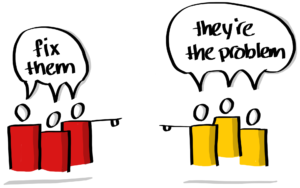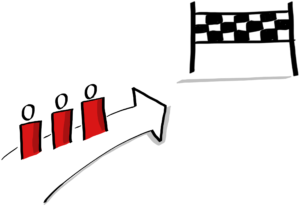 You’re coaching a new team! Woohoo! You have so many ideas! You’re going to help make the team’s world a better place! All the things that you’ll do! Then you get there. The music stops, and the frustration sets in. You’re trying to help but team members come late to the daily scrums, they don’t update the information radiators and they’re zoning out during meetings. You’re not sure what to do anymore. What happened? You feel undermined and unappreciated. Aren’t you the expert? Isn’t that why you got this team to begin with? Why won’t they let you help them?
You’re coaching a new team! Woohoo! You have so many ideas! You’re going to help make the team’s world a better place! All the things that you’ll do! Then you get there. The music stops, and the frustration sets in. You’re trying to help but team members come late to the daily scrums, they don’t update the information radiators and they’re zoning out during meetings. You’re not sure what to do anymore. What happened? You feel undermined and unappreciated. Aren’t you the expert? Isn’t that why you got this team to begin with? Why won’t they let you help them?
Let’s look at the journey of joining a team and how you can pave the way for a successful coaching experience!
Coaching a team can be broken into three parts:
- Starting the coaching relationship
- Setting goals
- Working with the team
Starting the coaching relationship
 How did you start your coaching engagement? Did a manager or stakeholder reach out and say: “We would be more successful, if only our teams worked better. Please help us by coaching our teams”? What message does this send to you as coach, and to the team? I hear this message:
How did you start your coaching engagement? Did a manager or stakeholder reach out and say: “We would be more successful, if only our teams worked better. Please help us by coaching our teams”? What message does this send to you as coach, and to the team? I hear this message:
- The team is broken
- We need you to fix the team
Does the team see it the same way? If they don’t, approaching the team as their savior will backfire. Instead, start out by checking your intent. It’s gratifying to feel like a knight in shining armor, but coaching isn’t about saving people. A coach and facilitator’s main focus is to raise the awareness of the team members about their situation, their responsibility and the options that are available to them. Coaches use their expertise to create a space for the participants to work constructively together. The coach does not drive a particular outcome or solution.
Once you’re clear on your intent you can introduce yourself to the team. Be open to the input and information you get from them. Listen and observe. Be curious – ask questions. Be honest – share your observations.
Setting a goal
 The next step is to articulate the team’s needs. The easiest way is to ask the team what they’d like to accomplish. Questions like the following can inspire the teams to talk about what’s important to them:
The next step is to articulate the team’s needs. The easiest way is to ask the team what they’d like to accomplish. Questions like the following can inspire the teams to talk about what’s important to them:
- What does “success” mean to us?
- If you look forward to coming to work on Mondays what would work look like in that case?
- If we have the best launch ever what does that look like?
- What are the most important factors for retaining members of our team?
- What can we do to make this the team that others would love join?
Discussing aspirations and dreams is an important first step, because this will be the guiding star. The team members now know what’s important to each of them and what’s important for them as a group. This shared vision will help define the goals that the team hopes to achieve. The team then prioritizes the goals to create a shared improvement backlog, for you as a coach and for the team!
Once the team has set goals, you can work with them to make sure they know how to verify that a goal is met. Next, agree on how to follow up and update the goals and how to visualize progress. Working with the goals may include techniques, methods and tools from the agile world, this is where you have expert knowledge. Remember, though, that tools and processes are not the ends, they’re just the means. Focus on the team and their goals, not on the methods used to achieve or measure the goals.
Working with the team
 With a proper start to the relationship and a set of team goals with you’re ready to get to work! The best place to start is to look at the current state. The team members know where they want to go, but do they know where they are today? Tie this investigation to the goals. Some questions that might be relevant:
With a proper start to the relationship and a set of team goals with you’re ready to get to work! The best place to start is to look at the current state. The team members know where they want to go, but do they know where they are today? Tie this investigation to the goals. Some questions that might be relevant:
- How well they are at communicating: Within the team? With externals?
- How confident are they in their ability to deliver features?
- Do they have all they need to be able to succeed?
- What is their collaboration like, what about the team atmosphere?
- Lead times? Quality? Prioritization?
Collaborate with the team to see where they are today and to identify the next step based on the prioritized list of goals. Make sure to have group discussions to achieve alignment. Find commonalities, highlight strengths and identify improvements. Maybe they need to make major changes, or maybe they just need minor adjustments. Regardless of the outcome, you’re now partners working together!
Let’s coach!
Coaching teams is fun! Remember to check your intent, identify goals and partner with the team to achieve those goals!
Get in touch via my homepage if you have questions or comments!



Very good blog post!
From my experience – It’s very important to be consistent, show patience and be repetitive with respect to the purpose to the teams deliveries and fulfilment of the goals during the journey.
//Erik